
Karst is a topography formed from the dissolution of soluble carbonate rocks such as limestone and dolomite. It is characterized by features like poljes above and drainage systems with sinkholes and caves underground. There is some evidence that karst may occur in more weathering-resistant rocks such as quartzite given the right conditions.

Meliaceae, the mahogany family, is a flowering plant family of mostly trees and shrubs in the order Sapindales.
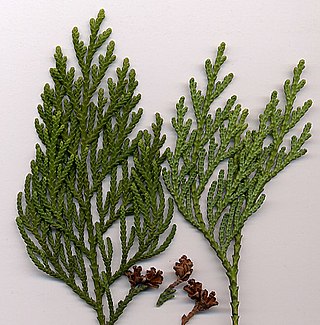
Thuja is a genus of coniferous tree or shrub in the Cupressaceae. There are five species in the genus, two native to North America and three native to eastern Asia. The genus is monophyletic and sister to Thujopsis. Members are commonly known as arborvitaes, thujas or cedars.
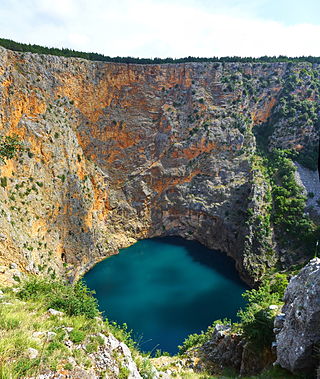
A sinkhole is a depression or hole in the ground caused by some form of collapse of the surface layer. The term is sometimes used to refer to doline, enclosed depressions that are also known as shakeholes, and to openings where surface water enters into underground passages known as ponor, swallow hole or swallet. A cenote is a type of sinkhole that exposes groundwater underneath. Sink, and stream sink are more general terms for sites that drain surface water, possibly by infiltration into sediment or crumbled rock.

Obdurodon is a genus of extinct platypus-like Australian monotreme which lived from the Late Oligocene to the Late Miocene. Three species have been described in the genus, the type species Obdurodon insignis, plus Obdurodon dicksoni and Obdurodon tharalkooschild. The species appeared much like their modern day relative the platypus, except adults retained their molar teeth, and unlike the platypus, which forages on the lakebed, they may have foraged in the water column or surface.

The family Campanulaceae, of the order Asterales, contains nearly 2400 species in 84 genera of herbaceous plants, shrubs, and rarely small trees, often with milky sap. Among them are several familiar garden plants belonging to the genera Campanula (bellflower), Lobelia, and Platycodon (balloonflower). Campanula rapunculus and Codonopsis lanceolata are eaten as vegetables. Lobelia inflata, L. siphilitica and L. tupa and others have been used as medicinal plants. Campanula rapunculoides may be a troublesome weed, particularly in gardens, while Legousia spp. may occur in arable fields.

Cyathea is a genus of tree ferns, the type genus of the fern order Cyatheales.
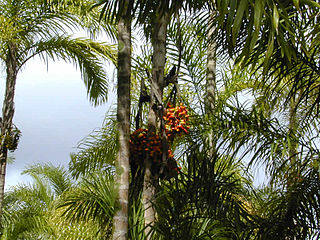
Bactris is a genus of spiny palms which are native to Mexico, South and Central America and the Caribbean. Most species are small trees about 2 m tall, but some are large trees while others are shrubs with subterranean stems. They have simple or pinnately compound leaves and yellow, orange, red or purple-black fruit. The genus is most closely related to several other spiny palms—Acrocomia, Aiphanes, Astrocaryum and Desmoncus. The fruit of several species is edible, most notably B. gasipaes, while others are used medicinally or for construction.

Caryodendron is a plant genus of the family Euphorbiaceae first described as a genus in 1860. The genus includes C. orinocense, known as the Inchi tree or Tacay nut. It is native to Central America and South America. They are dioecious trees.
- Caryodendron amazonicumDucke - Amazonas in Brazil
- Caryodendron angustifoliumStandl. - Costa Rica, Panama, Colombia
- Caryodendron janeirenseMüll.Arg. - Rio de Janeiro
- Caryodendron orinocenseH.Karst - Colombia, Venezuela, Ecuador

Myoxanthus is a genus of orchids with about 50 species, widely distributed in Central and South America. This genus is a close ally of Pleurothallis.

Iriartea is a genus in the palm family Arecaceae, native to Central and South America. The best-known species – and probably the only one – is Iriartea deltoidea, which is found from Nicaragua, south into Bolivia and a great portion of Western Amazonian basin. It is the most common tree in many forests in which it occurs.
In phylogenetics, basal is the direction of the base of a rooted phylogenetic tree or cladogram. The term may be more strictly applied only to nodes adjacent to the root, or more loosely applied to nodes regarded as being close to the root. Note that extant taxa that lie on branches connecting directly to the root are not more closely related to the root than any other extant taxa.
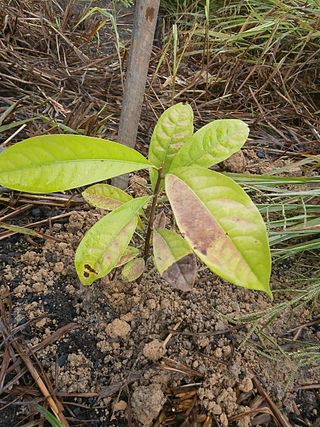
Aniba is an American neotropical flowering plant genus in the family Lauraceae. They are present in low and mountain cloud forest in Caribbean islands, Central America, and northern to central South America.
Pseudolmedia is a flowering plant genus in the mulberry family (Moraceae). Species are found in southern Mexico, the Caribbean, and Meso- and South America. They are known in Latin America as lechechiva and used for timber, construction wood, and sometimes in folk medicine.

Rustia is a genus of flowering plants in the family Rubiaceae. There are 17 species distributed in tropical Central and South America. They are shrubs and trees up to 15 metres (49 ft) tall.
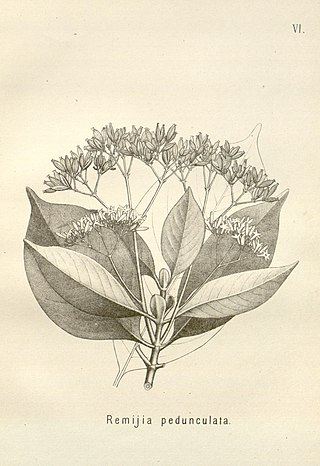
Ciliosemina is a genus of flowering plants in the family Rubiaceae. There are two recognized species distributed in South America from the eastern Andes to the Amazon basin.

Dialypetalantheae, synonym Condamineeae, is a tribe of flowering plants in the family Rubiaceae and contains about 305 species in 31 genera. Most genera are found in Central and Southern Tropical America, but a few occur in Southeast Asia.
Maquira is a genus of trees in the family Moraceae, native to South America.

Mayna is a genus of shrubs and trees in the family Achariaceae. It is native to the American tropics. It is dioecious, with male and female flowers produced on separate individuals.















